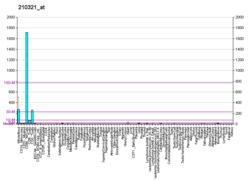GZMH
Granzyme H is a protein that in humans is encoded by the GZMH gene.[3][4]
References
Further reading
- Waterhouse NJ, Trapani JA (2007). "H is for helper: granzyme H helps granzyme B kill adenovirus-infected cells.". Trends Immunol. 28 (9): 373–5. PMID 17766182. doi:10.1016/j.it.2007.08.001.
- Llorens C, Martres MP, Baudry M, Schwartz JC (1978). "Hypersensitivity to noradrenaline in cortex after chronic morphine: relevance to tolerance and dependence.". Nature. 274 (5671): 603–5. PMID 209336. doi:10.1038/274603a0.
- Heusel JW, Hanson RD, Silverman GA, Ley TJ (1991). "Structure and expression of a cluster of human hematopoietic serine protease genes found on chromosome 14q11.2.". J. Biol. Chem. 266 (10): 6152–8. PMID 2007574.
- Meier M, Kwong PC, Frégeau CJ, et al. (1990). "Cloning of a gene that encodes a new member of the human cytotoxic cell protease family". Biochemistry. 29 (17): 4042–9. PMID 2193684. doi:10.1021/bi00469a003.
- Hanson RD, Hohn PA, Popescu NC, Ley TJ (1990). "A cluster of hematopoietic serine protease genes is found on the same chromosomal band as the human alpha/delta T-cell receptor locus". Proc. Natl. Acad. Sci. U.S.A. 87 (3): 960–3. PMC 53389
 . PMID 2300587. doi:10.1073/pnas.87.3.960.
. PMID 2300587. doi:10.1073/pnas.87.3.960.
- Klein JL, Selvakumar A, Trapani JA, Dupont B (1990). "Characterization of a novel, human cytotoxic lymphocyte-specific serine protease cDNA clone (CSP-C)". Tissue Antigens. 35 (5): 220–8. PMID 2402757. doi:10.1111/j.1399-0039.1990.tb01787.x.
- MacIvor DM, Pham CT, Ley TJ (1999). "The 5' flanking region of the human granzyme H gene directs expression to T/natural killer cell progenitors and lymphokine-activated killer cells in transgenic mice". Blood. 93 (3): 963–73. PMID 9920846.
- Edwards KM, Kam CM, Powers JC, Trapani JA (1999). "The human cytotoxic T cell granule serine protease granzyme H has chymotrypsin-like (chymase) activity and is taken up into cytoplasmic vesicles reminiscent of granzyme B-containing endosomes". J. Biol. Chem. 274 (43): 30468–73. PMID 10521426. doi:10.1074/jbc.274.43.30468.
- Strausberg RL, Feingold EA, Grouse LH, et al. (2003). "Generation and initial analysis of more than 15,000 full-length human and mouse cDNA sequences". Proc. Natl. Acad. Sci. U.S.A. 99 (26): 16899–903. PMC 139241
 . PMID 12477932. doi:10.1073/pnas.242603899.
. PMID 12477932. doi:10.1073/pnas.242603899.
- Johnson H, Scorrano L, Korsmeyer SJ, Ley TJ (2003). "Cell death induced by granzyme C". Blood. 101 (8): 3093–101. PMID 12515723. doi:10.1182/blood-2002-08-2485.
- Sedelies KA, Sayers TJ, Edwards KM, et al. (2004). "Discordant regulation of granzyme H and granzyme B expression in human lymphocytes". J. Biol. Chem. 279 (25): 26581–7. PMID 15069086. doi:10.1074/jbc.M312481200.
- Gerhard DS, Wagner L, Feingold EA, et al. (2004). "The status, quality, and expansion of the NIH full-length cDNA project: the Mammalian Gene Collection (MGC)". Genome Res. 14 (10B): 2121–7. PMC 528928
 . PMID 15489334. doi:10.1101/gr.2596504.
. PMID 15489334. doi:10.1101/gr.2596504.
- Andrade F, Fellows E, Jenne DE, et al. (2007). "Granzyme H destroys the function of critical adenoviral proteins required for viral DNA replication and granzyme B inhibition". EMBO J. 26 (8): 2148–57. PMC 1852776
 . PMID 17363894. doi:10.1038/sj.emboj.7601650.
. PMID 17363894. doi:10.1038/sj.emboj.7601650.
- Fellows E, Gil-Parrado S, Jenne DE, Kurschus FC (2007). "Natural killer cell-derived human granzyme H induces an alternative, caspase-independent cell-death program". Blood. 110 (2): 544–52. PMID 17409270. doi:10.1182/blood-2006-10-051649.

 . PMID 2300587. doi:10.1073/pnas.87.3.960.
. PMID 2300587. doi:10.1073/pnas.87.3.960. . PMID 12477932. doi:10.1073/pnas.242603899.
. PMID 12477932. doi:10.1073/pnas.242603899. . PMID 15489334. doi:10.1101/gr.2596504.
. PMID 15489334. doi:10.1101/gr.2596504. . PMID 17363894. doi:10.1038/sj.emboj.7601650.
. PMID 17363894. doi:10.1038/sj.emboj.7601650.